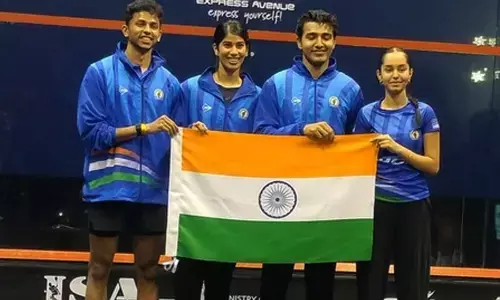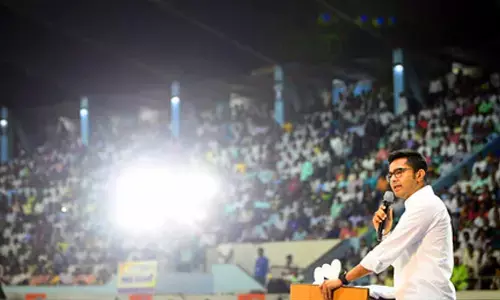Manifesto that doesn’t inspire
Manifesto that doesn’t inspire, Rahul Gandhi’s stamp, K Ramachandra Murthy. First, let us examine the manifesto. It has Rahul Gandhi’s stamp. The three most important persons heading the UPA-II dispensation, Sonia Gandhi, Manmohan Singh and Rahul Gandhi spoke for the first time from the same platform.
The contrast between the Congress and the BJP could not have been more pronounced. It is more about style than substance. Both the parties are committed to market economy. Both are pro-US. The foreign policy they follow is the same. Vajpayee continued the foreign policy initiatives of PV Narasimha Rao and Manmohan Singh carried forward Vajpayee’s ideas on India-Pakistan relations to the extent possible in the given conditions. It is natural for the challenger to be aggressive. But BJP’s Prime Ministerial candidate Narendra Bhai Modi appears to be unreasonably so.
First, let us examine the manifesto. It has Rahul Gandhi’s stamp. The three most important persons heading the UPA-II dispensation, Sonia Gandhi, Manmohan Singh and Rahul Gandhi spoke for the first time from the same platform. The manifesto, titled ‘The open manifesto process, Path-breaking Political Reform’, boasted of pioneering an entirely new way. It spoke of Rahul Gandhi’s meetings in several parts of the country, stretched over five months, in which he met people from a cross section of society to know their priorities. This kind of exercise was not undertaken by any top leader of a national party. The idea no doubt is novel. But the interaction was so short and peripheral that it is difficult to understand the needs and aspirations of the people. Here is a party that failed to implement many promises made in 2009 manifesto. The glaring failures are in connection with reservation of 33 per cent seats for women, implementation of recommendations of the Administrative Reforms Commission and National Knowledge Commission. In spite of this Rahul had the audacity to claim that 90 per cent of the promises made in the manifesto of 2009 have been implemented. The latest manifesto promised Right to Health, Right to Homestead and Right to Pension. These promises are in line with other rights given by UPA like Right to Information, Right to Work, Right to Education and Right to Food. While the RTI Act is being made use of by the citizens to some extent, right to work and education are not satisfactorily implemented. It is extremely difficult to enforce the right to food. The manifesto is bereft of new ideas. It is only expected of a tired party. The young scion of Nehru-Gandhi dynasty was expected to provide some buoyancy. He disappointed once again. For a party which ruled for ten years, manifesto hardly matters. People would go by their experience rather than promises made in manifestos. The crowds that have been gathering to hear Modi at the series of meetings from Kashmir to Kanykumari is proof enough of the disenchantment that has set in the people.
While Congress president Sonia Gandhi was releasing the party manifesto for the impending general election, Narendra Modi was spitting fire on the Congress in his inaugural address at Bharat Vijay Rally in Jammu on Wednesday afternoon. Congress party has reaffirmed its faith in the pro-poor agenda positioning itself firmly on the left of the Centre. This is an ideological position which is quite different from the position of NDA. Congress Vice-President Rahul Gandhi specifically mentioned that the Modi’s ideology will hurt India. Modi retorted by saying that Rahul Gandhi’s and the Congress party’s ideology has ruined the country.
Sonia Gandhi particularly spoke about secularism as an article of faith with the Congress saying that her party would strive to unite the people by fighting for secular India. Rahul said Narendra Modi represents a thought process which is exclusionary that pits people against each other. Modi, in turn, was at his sarcastic best playing on the word ‘secularism’. “If I say the unemployed should be provided with jobs, they say secularism is in danger; When I demand that the prices of essential commodities have to be brought down, they say let us first discuss secularism…”, taunted Modi punning on secularism. It is, of course, not a laughing matter. When Sonia was telling the nation that the welfare of the farmers is of top most priority for her party (In spite of the fact that more than 30,000 farmers committed suicide in Andhra Pradesh alone in the last 15 years), Modi was ridiculing the ruling party saying that it changed former Prime Minister Lal Bahadur Sastri’s slogan “Jai Jawan Jai Kisan” into “Mar Jawan Mar Kisan”. Though Modi sounded a little unkind, the fact remains that the farmers were not able to live with dignity in UPA regime, although the tragedy of farmers’ suicides started in 1998 itself when NDA was ruling the country and the TDP was in office at the State level. There is little to choose between the two parties as far as corruption is concerned. NDA’s Prime Minister Vajpayee and UPA’s Manmohan Singh are personally incorruptible. But they had Cabinet and party colleagues who were known to be corrupt. The BJP chief ministers of Gujarat, Madhya Pradesh and Chhattisgarh are less corrupt than their Congress counterparts. The degree and dimension may be different. With the media becoming strong and unsparing, though sometimes selective, the expose have been devastating in recent times and they have a salutary effect. But the approach of both the parties to the scourge of corruption is almost similar. The stand depends where a particular party stands. Arun Jaitley making a lot of noise on nominating Ashok Chawan from Nanded Lok Sabha constituency in Maharashtra is a case in point. The Maratha leader was allegedly involved in ‘Aadarsh scam’. The courts have refused to drop charges against him. He should not have been nominated by the Congress. When questioned by the media, Sonia said no law has banned Ashok Chavan from contesting election. It blunted Rahul’s anti-corruption pitch. However, Arun Jaitley’s remarks carry no value since the BJP admitted Yeddyurappa, former chief minister of Karnataka, who faces serious corruption charges. So, Yeddy and Sriramulu on one side and Ashok Chavan and Bansal on the other cancel one another. Both the national parties evidently have no compunction on account of corruption.
Modi has been describing Rahul Gandhi as ‘Hindustan ka Shahzada’ (prince of India) pointing to the family rule in the Congress. But Modi has constituents of the NDA which are controlled by ruling dynasties. That is why Omar Abdulla, Chief Minister of J&K, who himself is a dynast, a third generation chief minister at that, challenged Modi to talk about family rule in Punjab where the ruling Akali Dal is controlled by a family and Maharashtra which has been witnessing a prolonged battle between cousins, Uddhav and Raj Thackeray, for Bal Thackeray’s mantle. Modi accused three AKs of helping Pakistan and harming India. They are AK-47, AK Antony, AK-49. AK-47 was developed in Soviet Union by Mikhail Kalashnikov at the time of the Second World War. This automatic weapon is used mostly by the militants in Kashmir and terrorists who infiltrate from Pakistan. AK Antony is Defense Minister who told parliament that the killers who beheaded our soldiers at the border are terrorists wearing Pakistan army uniform. Modi finds fault with this description. He insists that they are Pakistan Army regulars. The AK-49 is Arvind Kejriwal whose tenure as chief minister of Delhi lasted just 49 days. He accuses Kejriwal of including Kashmir in Pakistan in the map given in his website. It is Modi’s first attack on the AAP leader. Modi sounded a bit desperate when he spoke of three AKs. May be he is deliberately raising the pitch of his campaign since elections are fast approaching. He appears to have accepted Kejriwal as a challenger after ignoring for a number of weeks after launching his campaign.
The promise made by the manifesto to work for reservations in jobs for the SCs and STs in private sector is yet another indication of the welfare angle to the UPA that the Congress party would like to highlight. Rahul rightly said any government that is out and out pro-business or out and out pro-poor would not be suitable for India. It has to be balanced. Wealth has to be created first and then distributed properly to bring more people above the poverty line. Manmohan Singh claimed that UPA did better than NDA in registering a reasonable rate of growth (5.5 %) on an average. But the markets are responding to Modi in an overwhelming manner.
The investors are eagerly waiting for Modi to take over. The rich and the upper middle class adore him. But what do the poor and the lower middle class think of Modi? How welcome he would be for them? What is that the BJP is doing to win them over? They are the ones who take the trouble of going to the polling booths and waiting for their turn to vote. The Congress party is evidently banking on them. At least the party’s manifesto suggests that.















